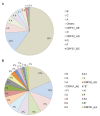Current Trends of HIV Recombination Worldwide
- PMID: 24470968
- PMCID: PMC3892622
- DOI: 10.4081/idr.2013.s1.e4
Current Trends of HIV Recombination Worldwide
Abstract
One of the major characteristics of HIV-1 is its high genetic variability and extensive heterogeneity. This characteristic is due to its molecular traits, which in turn allows it to vary, recombine, and diversify at a high frequency. As such, it generates complex molecular forms, termed recombinants, which evade the human immune system and so survive. There is no sequence constraint to the recombination pattern as it appears to occur at inter-group (between groups M and O), as well as interand intra-subtype within group M. Rapid emergence and active global transmission of HIV-1 recombinants, known as circulating recombinant forms (CRFs) and unique recombinant forms (URFs), requires urgent attention. To date, 55 CRFs have been reported around the world. The first CRF01_AE originated from Central Africa but spread widely in Asia. The most recent CRF; CRF55_01B is a recombinant form of CRF01_AE and subtype B, although its origin is yet to be publicly disclosed. HIV-1 recombination is an ongoing event and plays an indispensable role in HIV epidemics in different regions. Africa, Asia and South America are identified as recombination hot-spots. They are affected by continual emergence and cocirculation of newly emerging CRFs and URFs, which are now responsible for almost 20% of HIV-1 infections worldwide. Better understanding of recombinants is necessary to determine their biological and molecular attributes.
Keywords: HIV; current trends.
Figures


References
-
- Coffin J, Haase A, Levy JA, et al. What to call the AIDS virus? Nature 1986;321:10. - PubMed
-
- Reeves JD, Doms RW. Human immunodeficiency virus type 2. J Gen Virol. 2002; 83:1253-65 - PubMed
-
- Clavel F. HIV-2, the West African AIDS virus. AIDS 1987;1:135-40 - PubMed
-
- McCutchan FE. Understanding the genetic diversity of HIV-1. AIDS2000;14 Suppl 3:S31-44 - PubMed
-
- Peeters M, Sharp PM. Genetic diversity of HIV-1: the moving target. AIDS 2000;14 Suppl 3:S129-40 - PubMed
Publication types
LinkOut - more resources
Full Text Sources
Other Literature Sources
Research Materials
